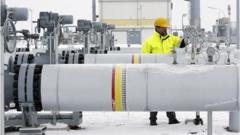
European Union Embarks on Ambitious Plan to Sever Energy Ties with Russia
A Paradigm Shift in Energy Policy Following the Ukraine Invasion
In the wake of Russia's full-scale invasion of Ukraine in February 2022, the European Union (EU) committed to a significant and transformative policy shift: ending its reliance on Russian energy sources. This ambitious endeavor, driven by both geopolitical considerations and a renewed focus on energy security, represents a fundamental reshaping of the European energy landscape.
The Pre-Invasion Energy Dependency
Prior to the conflict, the EU was heavily dependent on Russia for its energy needs, particularly natural gas. Russia supplied approximately 40% of the EU's natural gas imports, a dependence that gave Moscow considerable leverage over European economies and political decision-making. This dependency varied significantly across member states, with some countries, particularly in Eastern and Central Europe, being almost entirely reliant on Russian gas.
The reliance on Russian energy extended beyond natural gas, encompassing crude oil and coal as well. This multifaceted dependence created a complex web of economic and political ties that the EU now seeks to disentangle.
Immediate Responses and Sanctions
Following the invasion, the EU implemented a series of sanctions against Russia, targeting various sectors of the Russian economy. While energy was initially excluded from the harshest sanctions, the EU gradually introduced measures aimed at reducing its dependence on Russian fossil fuels. These measures included:
- Phased bans on Russian coal and oil imports: These bans aimed to progressively cut off revenue streams that supported the Russian war effort.
- Efforts to diversify gas supplies: The EU actively sought alternative gas suppliers, including Norway, Algeria, and the United States, and invested in infrastructure to facilitate gas imports from these sources.
- Increased investments in renewable energy sources: The invasion accelerated the EU's existing commitment to renewable energy, with ambitious targets set for expanding solar, wind, and hydrogen power generation.
- Demand reduction measures: The EU encouraged member states to implement measures to reduce energy consumption, such as promoting energy efficiency and encouraging citizens to conserve energy.
Diversification Strategies and Infrastructure Investments
Diversifying energy supplies has been a central pillar of the EU's strategy. This involved a multi-pronged approach:
- Securing alternative gas supplies: The EU has worked to secure long-term gas supply contracts with countries like Norway, Azerbaijan and the United States. Increased imports of Liquefied Natural Gas (LNG) have played a crucial role in replacing Russian gas.
- Developing new gas infrastructure: Investments in pipelines and LNG terminals have been essential for facilitating the import and distribution of non-Russian gas within the EU. Projects like the Baltic Pipe, connecting Norway to Poland and Denmark, and expansions of LNG import terminals in various member states, have significantly increased the EU's import capacity.
- Promoting energy efficiency: Reducing energy consumption through improved building insulation, more efficient appliances, and behavioral changes has been a key strategy for lessening the overall demand for energy, thereby reducing the need for Russian imports.
- Accelerating the transition to renewable energy: The EU has significantly increased its investments in renewable energy projects, aiming to achieve a rapid expansion of solar, wind, and other renewable energy sources. This includes streamlining permitting processes, providing financial incentives, and promoting research and development in renewable energy technologies.
Challenges and Obstacles
The transition away from Russian energy has not been without its challenges. Some of the key obstacles include:
- High energy prices: The reduction in Russian energy supplies has contributed to significant increases in energy prices, impacting households and businesses across the EU.
- Supply chain disruptions: The rapid shift in energy sources has created challenges in supply chains, leading to potential shortages and delays.
- Inter-state cooperation: Ensuring effective coordination and cooperation among member states has been crucial for successfully implementing the energy transition. Different member states have different energy mixes and priorities, which can make it challenging to reach consensus on EU-wide policies.
- Economic impact: The energy transition has significant economic implications, requiring substantial investments and potentially impacting industries that are heavily reliant on fossil fuels.
Long-Term Implications
The EU's commitment to ending its energy dependence on Russia has far-reaching implications for the European economy, energy security, and geopolitical landscape. In the long term, this transition is expected to:
- Strengthen energy security: By diversifying its energy sources, the EU aims to reduce its vulnerability to geopolitical risks and supply disruptions.
- Accelerate the transition to a low-carbon economy: The focus on renewable energy will contribute to the EU's climate goals and reduce its greenhouse gas emissions.
- Reshape the geopolitical landscape: The reduced reliance on Russian energy will diminish Russia's leverage over European countries and potentially alter the balance of power in the region.
- Promote innovation and economic growth: Investments in renewable energy and energy efficiency technologies are expected to spur innovation and create new economic opportunities.
Conclusion
The European Union's endeavor to sever its energy ties with Russia represents a monumental undertaking. While the transition presents significant challenges, it also offers a unique opportunity to enhance energy security, accelerate the transition to a sustainable energy system, and reshape the geopolitical landscape. The success of this endeavor will depend on sustained political will, effective cooperation among member states, and continued investments in renewable energy and energy efficiency.
